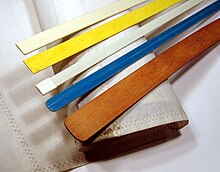Sail batten
Appearance


On
tall ships to form the ladders up the shrouds in a fashion similar to ratlines
.
History
Battened sails are commonly found in
Bayon temple at Angkor Thom, Cambodia.[4]: 460–461 From its characteristics and location, it is likely that the ship depicted in Bayon was a Southeast Asian ship.[5]: 188–189 The Chinese themselves may have adopted them around the 12th century CE.[6]: 21 Their rigs featured full-length battens that facilitated short-handed sail handling, including reefing.[7]
Applications in sails
The most common use of sail battens is in the
clew of the sail to create a wider sail towards the top. Cruising sailboats may have four to six battens. Racing sailboats may have full-length battens, as well, that allow for better sail shape. Batten length near the head of the sail is limited by the need for the roach to pass ahead of the backstay, when tacking or jibing.[1] Battens are also found in jibs of beach-cat catamarans.[8]
Batten materials and construction
Most modern battens are fiberglass pultrusions with a thin, rectangular cross section. An alternative shape is a hollow tube that rotates in the batten pocket and is more compatible with roller furling the mainsail. Because the ends of battens are likely to chafe the sail at the ends of the pockets into which they are inserted, they often have a soft, blunt shape affixed to them.[1]
References
- ^ ISBN 0924486813.
- ^ Needham 1986, pp. 456–457.
- ^ See also plates CDIII, CDIV, CDV, CDVI in Needham, Volume 4, Part 3.
- ^ Needham, Joseph (1971). Science and Civilisation in China: Volume 4, Physics and Physical Technology, Part 3, Civil Engineering and Nautics. Cambridge University Press.
- ^ Burningham, Nick (2019). "Chapter 6: Shipping of the Indian Ocean World". In Schottenhammer, Angela (ed.). Early Global Interconnectivity across the Indian Ocean World, Volume II: Exchange of Ideas, Religions, and Technologies. Cham: Palgrave Macmillan. pp. 141–201.
- ISBN 978-92-9223-414-0.
- ^
Mudie, Rosemary; Mudie, Colin (1975), The history of the sailing ship, Arco Publishing Co., p. 152, ISBN 9780668037808
- ^
Berman, Phil (1999). Catamaran Sailing: From Start to Finish. W. W. Norton & Company. p. 219. ISBN 9780393318807.
Look up batten in Wiktionary, the free dictionary.
